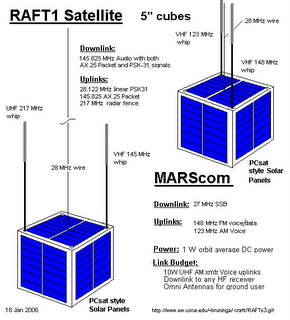
If STS-116 launches in December, it will carry two experimental satellites into orbit built by students at the US Naval Academy.
RAFT is a US Naval Academy Aerospace student project currently manifested on Space Shuttle Mission STS-116. It is designed to give students real hands on experience in satellite engineering, design and operations. The USNA RAFT hopes to accomplish the following objectives:
As usual there is the usual MARS frequency disclaimer on the main webpage stating that the MARS frequencies are sensitive and will not be published. But also as usual digging around the website and its links revealed the following:
RAFT1 Satellite
Downlink 145.825 MHz, 2 watts 20 kHz bandwidth FM with both AX.25 packet and PSK-31 signals
Uplinks
28.122 MHz linear PSK-31
216.980 MHz NSSS transponder (Radar fence)
RAFT1 Satellite Operating Modes:
Telemetry Mode, Packet Transponder Mode, PSK-31 Transponder Mode, Packet/Voice transponder, and the XP217 radar fence mode.
MARScom Satellite
148.975 MHz Uplink
27.9635 (27.962) MHz SSB downlink
123.100 MHz SAR AM Monitor
MARScom Satellite Operating Modes:
Telemetry Mode, Packet Transponder Mode, Voice Relay Mode, and SAR Monitor Mode.
What is amazing to me is that the brain thrust in MARS actually thought they could keep the frequencies of an orbiting satellite secret? Even DoD can't pull that one off. Bottom line, I will have more on these two cubesat birds as we approach the STS-116 mission launch.